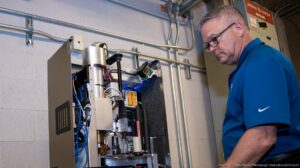How BioFlyte’s bioaerosol technology works

By Jacob Maranda New Mexico Inno
BioFlyte Inc., the Albuquerque startup partnering with Pittsburgh International Airport’s xBridge Innovation Center for a technology pilot program, has a pair of products for biological threat detection — a mail screening device and a bioaerosol identifier instrument. While the startup recently sold the first unit of the former to a New York investment firm, the latter is the focus of the Pittsburgh partnership.
The purpose of both products is to quickly identify biological threats. Those include things like bacteria, viruses, toxins and pharmaceutical-based threats, such as fentanyl.
To do that, BioFlyte employs “mass spectrometry.” It’s a process of identifying unknown compounds based on their molecular weights that’s typically used in drug testing and discovery, detecting food contamination or forensic toxicology.
In the case of BioFlyte, the startup uses mass spectrometry in its bioaerosol surveillance instruments to ionize particles collected from the air, accelerate them up a vacuum tube and accurately calculate the weight of the particles based on their speed — where the term “mass” comes from. That allows the instruments to determine the exact biological agents collected from samples of air.
That’s the fundamental mechanism behind BioFlyte’s technology. The instruments pull samples from ambient air in certain environments — in the case of the Pittsburgh International Airport partnership, from return air provided via an HVAC unit in the terminal core situated close to BioFlyte’s instrument.
But the instruments also employ artificial intelligence and machine learning capabilities to quickly and accurately identify and add new species from collected air samples to their libraries.
Testing air takes about five minutes. A sample disk within the bioaerosol instrument, as well as one microliter of a solvent mixture that’s added to collected samples, are the only components that have to be periodically replaced; the instruments can otherwise operate autonomously for long periods without significant user interaction and maintenance support.
“If there were a terrorist event, as an example, where somebody would come into the airport with a puffer — like a nose spray device — and release fentanyl, our unit is designed to quickly pick that up and allow airport emergency management and operations executives to initiate their protocols much faster to limit exposure to people and disruption of airport operations,” Todd Sickles, the CEO of BioFlyte, told Albuquerque Business First.
The pilot program with the innovation center is the first time BioFlyte has used one of its bioaerosol instruments in an operational environment. And, according to Sickles, “it’s the first time ever that mass spec[trometry]-based technology has been used operationally, outside the lab.”
Read the entire article here

